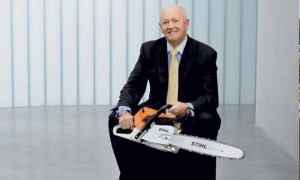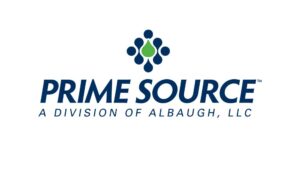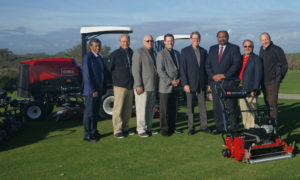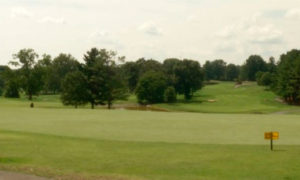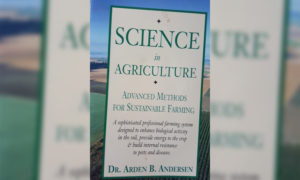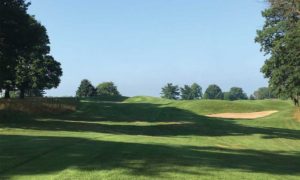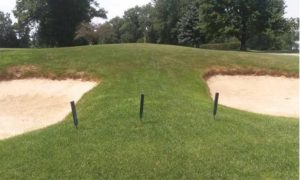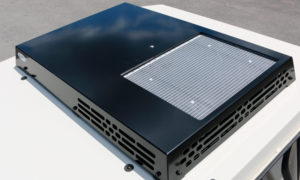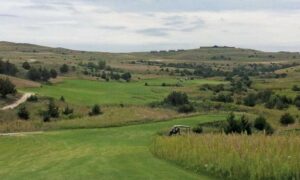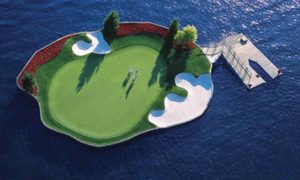Grass or Sand Greens?
A sheepherder sees a roundish stone and strikes it with the hook of his crook. He hits it again with increasing force as he walks along; enjoying the sensation of controlling the stone not to mention the pleasant click he hears each time the crook strikes the stone. Eventually he begins to hit the stone towards a rabbit scrape and upon closer proximity to this scrape he decides the interior part of the scrape will be the ultimate target. The shepherd then focuses his efforts on putting the stone in the hole. He utilizes more of a stroke motion rather than the swift blows he was inflicting moments ago. The stone seems to roll more than anything at this point and alas the ball goes in the rabbit hole.
So here’s a thought for discussion. When the first putt was made, was it on the grass or on the sand immediately surrounding the rabbit scrape? The point is the first greens could have been either and as the game of golf has evolved, both sand and grass have been used as putting surfaces. In more recent years of modern golf both bent and bermudagrass have been used to play our hallowed game.
In the southeastern United States the old timers remember putting on coarse bermudagrasses that were often bumpy and by today’s Stimpmeter standards very slow. They may well have complained that the old sand and oil greens were better and claimed “we never should have changed!” Then came the introduction of overseeding with rye grass and for the winter months the greens seemed a bit smoother and had pretty stripes from the mowers. After a while somebody got the idea to plant some bentgrass into these greens.
The bentgrasses did well and as they developed some disease pressures, new and improved fungicides became more available and were applied as a regular part of the management process. New and improved bentgrass varieties touting heat tolerance have helped as well. Most successful bentgrass greens in the southeast are grown on greens built using the United States Golf Association construction guidelines. The USGA method relies heavily on drainage for success. This is done through proper architectural design and the layered USGA method utilizing sand, stone and drainage pipe. The premise being you can always add more water through irrigation but removing excess water is a bit trickier.
The 20 Year Green – Fact or Fiction?
The USGA states clearly that properly constructed greens should last at least 20 years. That does not say that they will all last 20 years and does not imply they are all well built. Tis also refers to the construction – not the grass! So when USGA greens get a little older they are sort of like people. They slow down a bit (drainage). They know what they like and can become more demanding (hand watering). They get sick a little more often requiring increased medication (fungicides). They need a little help getting along like a cane or wheel chair (fans). Now this is where the analogy ends because to suggest that when a person passes away we should replace them with a newer better person would just be wrong! But a dead putting green is not a person and can, and indeed must, be replaced. While all these conditions can and will adversely affect bentgrass, bermudagrass can survive quite well on most old worn out USGA greens.
As the bentgrass research introduced improved varieties the bermudagrass breeders were not idle. The coarse old bermudas used for putting greens have steadily been improved and replaced. The first real improvement over the common bermudagrass called Tifgreen 328 and was introduced in 1956. (The “Tif” prefix for many bermudagrasses refers to Tifton Georgia where the University of Georgia has long been a leader of bermudagrass breeding and research). Tifgreen or 328 as it is commonly referred can still be found on some older courses throughout the south. In 1956 this grass could be mowed lower than the older commons which yielded better putting surfaces. Tifgreen is a good grass but is highly unstable in terms of mutations. This is the good and bad news. Instability through mutations leads to unsightly differences in the putting surfaces which act differently to the cultural practices like mowing, vertical mowing and aeration. The good news is that these mutations yielded an improved variety called Tifdwarf released in 1967.
Tifdwarf and Ultradwarf
Tifdwarf was a smaller plant than 328 and with a tighter coverage it left less open turf and thus produced a better putting surface. Not as good as bent but definitely better than any other bermudagrass. At this point in time the norm was to overseed the Tifdwarf with perennial ryegrass for winter color and improved winter putting quality. Unfortunately the ryegrass varieties began to improve which made them last longer into the summer each year delaying the full transition from rye back to bermudagrass. Ultimately, by the time the greens had fully transitioned it was mid to late summer and almost time to overseed again. Year after year this weakened the Tifdwarf to the point that bentgrass was often used as overseed and efforts made to keep it alive all summer were successful. This led to the more common practice of planting bentgrass greens in the southeast.
But the bermudagrass breeders were still at it. Selections from mutated Tifdwarf led to the introduction of a new standard of bermudagrasses for putting greens we now refer to as “ultradwarf”. There were seven varieties entered in the 1998 NTEP trials. NTEP is the National Turfgrass Evaluation Program which is headed by the USDA in Beltsville,
Maryland. The NTEP trials carry a lot of weight in the turf industry because they are
independent replicated trials conducted throughout the country by universities and golf courses. They are known to generate accurate and useful information that help turfgrass professionals like golf course superintendents make decisions based on unbiased scientific information.
Three of these seven new bermuda grasses from the 1998 trials became commercially successful and are now commonly planted throughout the southern portions of the United Sates and in warmer regions across the globe. The three grasses are MiniVerde, Champion and TifEagle. They are all classified as ultradwarf grasses and are all different. To learn the differences it is best to contact a grower or other knowledgeable turfgrass professional. As the author is a grower for MiniVerde he would obviously be the best person to ask.
Bent vs. Ultradwarf
The new ultradwarf bermudagrasses offer a host of advantages over bentgrass in the southeast. First and foremost it must be stated that ultradwarf putting quality is fantastic. But is bent better? There are a few weeks in the spring and a few weeks in the fall where bent is flawless and can be mowed as low as any mower can mow. During these periods the moisture content can be kept down a bit too making them firmer than normal. But the best measure between bent and ultradwarf greens is the number of days in a year that bermudagrass is better than bent. And of greater importance bermudagrass has a larger number of days of peak performance during peak playing times than bent. That means summer. Most golf is played in the summer when bent in the southeast is at its worst. Golfers play on wet, stinky, diseased, spiked up, ball marked, worn out, raised mowing heights to keep them alive, bentgrass greens in the summer. All these conditions exist until those late September nights when the fall begins to set in. That is what every southern bent manager anxiously awaits. Fall. They think if they can keep them alive until September they should have a job for next year… I used to grow bent greens in the southeast, I know the dread.
Also keep in mind ultradwarf bermudagrass greens are great in the winter. This can not be overstated. There is a popular misconception that the quality of putting on dormant grass is inferior. This just isn’t so. Covers are commonly used on very cold nights and paint is now used for color as opposed to overseeding. But the dormant putting surface during the winter is fantastic. Ultradwarf superintendents will learn the best speeds to maintain for winter play. The only drawback is if they get too fast, there is no slowing them down until the bermudagrass breaks dormancy in the early spring. By the way, we just had a very cold winter and there was a lot less bermudagrass replaced from the cold winter than bentgrass being replaced from the heat.
The USGA is pushing “fast and firm”. You heard it during the 2010 US Open at Pebble Beach and you will keep hearing it. There is more than one reason this term is becoming
the new norm. As a golf purist I like it because it represents the old way. Anybody who has played golf on the other side of the pond knows this is the way they do it. Nobody complains when they play in Scotland, Ireland and Europe, not even the Americans. The major difference in golf maintenance is over there they irrigate to keep grass alive. Over here we irrigate to keep it green. This could be a key reason the Europeans are winning the Ryder Cup regularly. Our golfers are great dart throwers, sticking the ball close to wet bent pin location, but so are theirs. Their golfers have great ground assaults where we lack skill and creativity. Make no mistake, ultradwarf putting greens exemplify “fast and firm”.
Making Golf Greener
Green is no longer good in the golf sense. Whether you are a believer in Global Climate Change or Global Warming is your decision. The fact is in the world of agriculture the climactic zones are changing. It is getting warmer. There is less water to go around. More scrutiny is focused on golf course operations than ever, monitoring the applications of water, fertilizer and chemicals. There are budget concerns like never before as well. Every aspect of the business side of golf is being reevaluated for fiscal responsibility and necessity. A lot of issues facing golf courses can be traced back to irrigation. The more water you use, the more fertilizer you will need because fertilizer leaches and breaks down faster with irrigation. The more fertilizer you use the more you will need to mow. Mowing costs include labor, fuel and wear and tear on equipment. Excess water and fertilizer will also lead to diseases which are cured with expensive fungicides.
So there we were, cooking in the middle of 2010. A very hot summer and bentgrass decline was rampant. What are the options for the average facility facing turf loss on bent greens? Wait until September to seed or sod. It is too hot to do it in the dead heat of the summer (Note the use of the word “dead” with heat only applies to bentgrass…). That is another downside of bent. When it goes bad you have to wait to fix it. Bermudagrass can be repaired or replaced any time of year. And if owners or memberships do decide to wait and seed or sod bent what is to prevent the same decline from occurring next year? If the greens are rebuilt for bent, the facility will face the expense of rebuilding along with the loss of cash flow while the course is closed for a long period. This solution will work though. With a new bentgrass variety and construction of new USGA greens coupled with a proper budget allowing for the necessary aerification frequency, fans, fungicides and hand watering, it can be done.
As budgetary restraints sometimes dictate the frequency of key cultural practices at many facilities, it should be noted that in the heat of the summer, when bentgrass goes south, it is rarely the result of an error made by the golf course superintendent. You can be sure older varieties of bent on older or poorly constructed greens will have problems when it gets very hot and wet in the summer.
The No-Till Method
The preferred method for transitioning old bent to new ultradwarf bermudagrass is called No-Till. The no-till method involves killing the remaining bent and any bermudagrass contamination, heavily verticutting the putting surfaces, aerifying them, adding new sand on top and planting bermudagrass sprigs. We have Champion Turf Farms from Bay City Texas to thank for pioneering the No-Till method. The important thing to realize here is that this method works for all ultradwarf grasses – not just Champion Dwarf Bermudagrass. After 6-8 weeks of watering, rolling, fertilizing, mowing and topdressing the new ultradwarf greens are ready for play. They don’t mind the poor growing conditions that were killing the bent because – well, they are simply hardier plants adapted to our climate. Take a walk down the road, any road in the transition zone. Start counting the volunteer bermudagrass plants. Count the volunteer bentgrass plants as well. Unless you’re in the mountains and near a ditch, you won’t find any bentgrass plants. There is a reason. It is called natural selection.
These are the things I think about and deal with every day. A little knowledge can be very helpful to the average golfer trying to figure it all out. The times are changing and like all others the golf industry must adapt to stay viable. If you frequent a facility that seems to struggle with bent greens in the summer perhaps you can offer some insight to spur the change. So whether the first putt was on sand or grass and whether you think you prefer bent over bermudagrass, if you wait long enough it all comes full circle. Who knows, we may be putting on sand and oil greens again sometime. I hear they’re slick this time of year!
_________________________________
Hank Kerfoot is owner of Modern Turf in Rembert, SC, a certified producer of MiniVerde bermudagrass and nine other quality turf types. He is a former golf course superintendent and serves on the USGA Green Section Committee.

